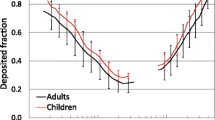Abstract
An experiment was designed to determine whether the respiratory retention of sytrene vapor, as estimated from measurements of end-exhaled air, was the same during periods of both constant and fluctuating exposure. Six human subjects were exposed to styrene inside an experimental chamber. A computer-controlled system was used to generate time-varying air concentrations of styrene over 4–5 h in both multistep sequences of constant exposure (four subjects exposed to 15–99 ppm. of styrene in 100-min steps) and fluctuating patterns representative of occupational exposures (two subjects exposed to mean concentrations of styrene of 50 ppm). In the latter case, lognormally distributed exposures, which fit one of two first-order autoregressive models, were generated at intervals of 2.5 min. It was found that the concentration of styrene in end-exhaled air was reduced by about half if the subject inhaled one to three breaths of clean air prior to sampling. This suggests that significant amounts of styrene were desorbed from the lining of the lungs during the initial exhalation. The retention of styrene vapor during constant exposures was 0.935 and was independent of the level. During each of the two sets of fluctuating exposure the retention of sytrene was also constant and was independent of both the variance and the autocorrelation coefficient. However, the retention of styrene during fluctuating exposure (estimates ranged from 0.957 to 0.973) was significantly higher than that observed during the constant exposures. It is speculated that the difference in retention between the constant and the fluctuating exposure regimens is related to non-steady-state behavior of styrene in the richly perfused tissues, as suggested by Opdam and Smolders (1986) regarding tetrachloroethylene exposure.
Similar content being viewed by others
References
ACGIH (1993) Threshold limit values and biological exposure indices for 1993–1994. American Conference of Governmental Industrial Hygienists, Cincinnati, Ohio
Åstrand I, Kilbom A, Ovrum P, Wahlberg I, Vesterberg O (1974) Exposure to styrene. I. Concentration in alveolar air and blood at rest and during exercise and metabolism. Work Environ Health 11:69–85
Bergert KL-D, Nestler K (1991) Solvent uptake in relation to physical activity. Sci Total Environ 101:111–119
Brugnone F, Perbellini L, Gaffuri E, Apostoli P (1980) Biomonitoring of industrial solvent exposures in workers' alveolar air. Int Arch Occup Environ Health 47:245–261
Chatfield C (1984) The analysis of time series. An introduction. Chapman and Hall, London
Dahl AR, Snipes MB, Gerde P (1991) Sites for uptake of inhaled vapors in beagle dogs. Toxicol App] Pharmacol 109:263–275
Droz PO, Guillemin MP (1983) Human styrene exposure. V. Development of a model for biological monitoring. Int Arch Occup Environ Health 53:19–36
Engström J, Bjurstrom R, Åstrand I, Ovrum P (1978) Uptake, distribution and elimination of styrene in man. Concentration in subcutaneous adipose tissue. Scand J Work Environ Health 4:315–323
Fernandez J, Caperos JR (1977) Exposition au styrene. I. Etude de 1'absorption et de 1'excretion pulmonaires sur des sujets humains. Int Arch Occup Environ Health 40:1–12
Koizumi A, Ikeda M (1981) A servomechanism for vapor concentration control in experimental exposure chambers. Am Ind Hyg Assoc J 42:417–425
Kumagai S, Matsunaga I, Kusaka Y (1993) Autocorrelation of short-term and daily average exposure levels in workplaces. Am Ind Hyg Assoc J 54:341–350
Löf A, Lundgren E, Byfalt-Nordgvist M (1986) Kinetics of styrene in workers from a plastics industry after controlled exposure: a comparison with subjects not previously exposed. Br J Ind Med 43:537–543
Male LM (1982) An experimental method for predicting plant yield response to pollution time series. Atmos Environ 16:2247–2252
Opdam JIG, Smolders JFJ (1986) Alveolar sampling and fast kinetics of tetrachloroethylene in man. II. Fast kinetics. Br J Ind Med 44:26–34
Perbellini L, Romeo L, Maranelli G, Zardoni C, Alexopoulos C, Brugnone F (1990) Biological monitoring of fluctuating occupational exposure to styrene. Med Lav 81:382–389
Pezzagno G, Ghittori S, Imbriani M, Capodaglio E (1985) Urinary elimination of styrene in experimental and occupational exposure. Scand J Work Environ Health 11:371–379
Rappaport SM (1994) Biological monitoring and standard setting in the U.S.A.: a critical appraisal. Toxicol Lett (in press)
Rappaport SM, Spear RC (1987) Physiological damping of exposure variability during brief periods. Ann Occup Hyg 32:21–33
Rappaport SM, Kure E, Petreas M, Ting D, Woodlee J (1991) A field method for measuring solvent vapors in exhaled air—application to styrene exposure. Scand J Work Environ Health 17:195–204
Roach SA (1977) A most rational basis for air sampling programmes. Ann Occup Hyg 20:65–84
Spear RC, Selvin S, Francis M (1986) The influence of averaging time on the distribution of exposures. Am Ind Hyg Assoc J 47:365–368
Wieczorek H, Piotrowski JK (1985) Evaluation of low exposure to styrene. I. Absorption of styrene vapours by inhaltion under experimental conditions. Int Arch Occup Environ Health 57:57–69
Yager JW, Paradisn W, Rappaport SM (1993) Sister chromatid exchanges in lymphocytes are increased in relation to longitudinally measured occuptional exposure to low concentrations of styrene. Mutat Res 319:155–165
Author information
Authors and Affiliations
Rights and permissions
About this article
Cite this article
Petreas, M.X., Woodlee, J., Becker, C.E. et al. Retention of styrene following controlled exposure to constant and fluctuating air concentrations. Int. Arch Occup Environ Heath 67, 27–34 (1995). https://doi.org/10.1007/BF00383129
Received:
Accepted:
Issue Date:
DOI: https://doi.org/10.1007/BF00383129




